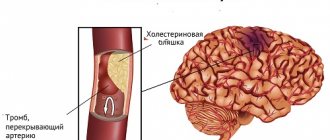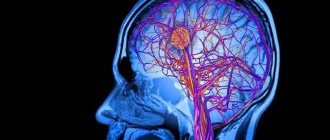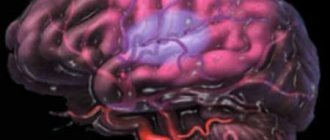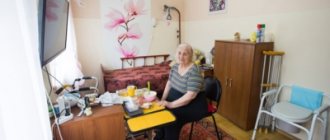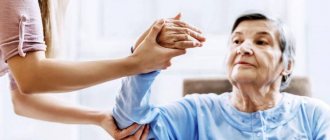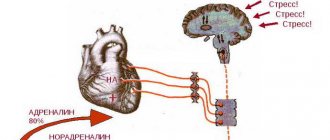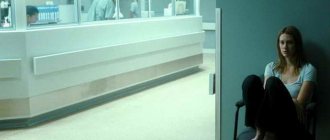What is ischemic cerebral stroke? It occurs when there is a significant decrease in blood flow in the brain - obstructions form in the blood vessels, which impede the flow of blood.
Most often, such obstacles are fatty deposits that line the vascular walls. The word “ischemia” means insufficiency of blood supply to a specific area of an organ or tissue of the human body.
“Stroke” is a lack of blood in the brain. If a vessel ruptures or ischemia occurs in one of the vessels, the cellular structures of the brain gradually begin to die.
Consequences for the brain
The extent to which the functions of the human body can recover after a stroke depends on the duration of ischemia and the number of dead cells.
According to statistics, complete recovery after a stroke is observed only in 10% of cases . This phenomenon is only possible if the inactivation of brain structures does not last long and the damage is minimal.
According to the level of changes, the consequences after a stroke can be:
- focal – develop as a result of hypoxia of brain areas;
- general cerebral – the brain swells, which is a universal reaction of the organ;
- meningeal – occur when the membranes of the brain are involved in the pathological process;
- – changes are observed in other organs and systems.
Also, the consequences after a stroke are divided into:
- early – formed within 5-21 days after the attack;
- late – appearing within 6-24 months.
Ischemic stroke has a code according to ICD-10:
- I63 Cerebral infarction;
- I64 Stroke not specified as hemorrhage or infarction;
- I67.2 Cerebral atherosclerosis.
Reference! Persistent residual effects can persist for more than 2 years.
Causes and symptoms of stroke
According to statistics, an attack is most often observed in men over 60 years of age, and in women over 75. The main causes of an attack include:
- vascular circulatory disorders;
- blockage of blood vessels with embolus (clumps of fat-like substances);
- degenerative modification of vessel walls (narrowing in areas);
- thrombosis (formation of blood clots);
- cerebral hemorrhage.
Thrombosis most often begins after surgery. It is usually observed in people who are overweight, those who smoke and drink alcohol, and those who take drugs. An attack due to a hemorrhage in the head can occur in any person, regardless of age. In general, it appears in people suffering from sudden changes in blood pressure, leading a sedentary and sedentary lifestyle, as well as in women who use oral contraceptives.
Symptoms of a stroke can be determined by a doctor or emergency medical technician. The main signs of the disease can be divided into two types: general cerebral and focal.
General cerebral symptoms include most abnormalities associated with traumatic brain injury. These may include incoordination, dizziness, temporary deafness or severe agitation. Focal symptoms include all the initial signs: unbalanced speech, poor coordination of movements, temporary loss of vision, muscle tension and distortion of the left side of the face due to the inability to contract muscles.
At the first general symptoms, a sick person should be immediately taken to the intensive care unit or call an ambulance. To determine whether a stroke is present, a number of tests are performed, such as magnetic resonance imaging (MRI), blood tests, and an electroencephalogram (EEG). Only after this the doctor can accurately diagnose the patient.
Speech Impairment
This is one of the most common consequences after a stroke.
Moreover, it can be one of the first symptoms when a brain stroke occurs.
The first option is that the patient can understand the interlocutor’s speech well, but is not able to give a formed answer. There are also difficulties with reading and writing.
Another variant of the violation is that a person does not understand the speech of the interlocutor, his own speech is incoherent.
The third option is that the patient speaks freely, but cannot name some objects.
Speech restoration is possible in the first year after a stroke; then this process slows down.
Rehabilitation
You need to start rehabilitation as soon as possible. The severity of stroke complications and each person's ability to recover varies greatly. People who participate in a targeted rehabilitation program do much better than people who don't. The recovery program is drawn up taking into account the specifics of the case, so it is impossible to talk about exact timing.
The main goal of rehabilitation is to improve the patient's condition and prevent another stroke.
Rehabilitation includes:
- speech therapy: speech restoration program;
- physiotherapy: exercises to strengthen muscles and coordinate movement;
- occupational therapy: helps a person improve their ability to perform routine daily activities such as bathing, cooking, dressing, eating and reading;
- support from friends and family;
- proper nutrition.
Healthy approach to nutrition
The diet includes consuming plenty of fruits, vegetables, whole grains and nuts. There is a limit on cholesterol and saturated fat intake. You need to minimize your salt intake to maintain healthy blood pressure.
Must eat:
- Lots of vegetables and fruits contain antioxidants, which can help reduce damage to blood vessels. They also contain potassium, which helps control blood pressure. Fiber from fruits and vegetables lowers cholesterol levels. Folic acid found in greens reduces the risk of recurrent stroke.
- High fiber grains such as rice, pasta, oats and barley.
- Lean meat and poultry, fish, eggs, nuts, seeds, legumes.
- Milk, yogurt, and low-fat cheese are sources of potassium along with calcium.
Limit consumption:
- Foods high in saturated fat - cookies, cakes, pastries, pies, meat products, pizza, fried foods, potato chips.
- Products that contain mainly saturated fats - butter, cream, coconut and palm oils.
- Salty foods that increase blood pressure.
- Drinks containing sugar: soft drinks and liqueurs, soda and energy drinks. Too much sugar can damage blood vessels.
- Alcohol.
Sometimes the patient has difficulty swallowing or chewing food. Food should be easy to swallow and soft. Do not prepare viscous food for the patient, such as jam, jelly, bananas - they can cause choking. Food should be finely chopped and not given in solid form. It is better to chew on the healthy side of the mouth. Cups and cutlery should have thick handles - they are easier to use.
Refusal of medications
Some patients refuse to take medications. There may be several reasons for this:
- the person feels well and does not see the need for medication;
- the medicine caused a side effect;
- laziness, reluctance to change habits and follow routines;
- disappointment from the lack of quick results.
Regardless of what form of stroke a person has suffered, his brain is faced with irreversible consequences, which in the future can lead to a second attack. The purpose of taking medications is to prevent the spread of the lesion to healthy brain cells, prevent a recurrent stroke, and restore damaged areas of the brain.
It is necessary to explain to the person that without taking medication his life is in danger. Some drugs do not have a visible clinical effect, but keep the body normal (for example, drugs that lower blood pressure). Recovery is a long process that requires patience and perseverance.
Mental disorders
Develop with damage to the temporal lobe. Cognitive disorders can be:
- subjective – memory and attention deteriorate, but patients do not experience any particular discomfort;
- lungs – have little effect on quality of life after a stroke;
- moderate – the patient’s daily life becomes difficult, even performing simple tasks takes a lot of time;
- severe - the patient is completely dependent on others, dementia, hysteria, and so on may occur.
Forecast for life
The prognosis after a stroke may be:
- Favorable. After a lesion, the patient loses some functions, but with quick and proper rehabilitation, these functions are gradually restored in full.
- Average Complications do not allow the patient to fully restore the functions, and he experiences alternating improvements and deterioration of his condition. In this case, doctors cannot give specific predictions.
- Unfavorable. Extensive brain damage does not exclude relapses, which in most cases leads to death. Days 3, 7 and 9 are considered critical. But the likelihood of relapse may persist for up to a year.
The following factors influence the forecast:
- The volume of the necrotic focus and its localization . Irreversible and serious manifestations of stroke develop with extensive damage to brain tissue. If the focus of necrosis is located in important centers of the brain, the likelihood of death increases. With a cerebellar stroke, the prognosis is extremely unfavorable; the patient’s death can occur in the shortest possible time. With a stroke of the brain stem, the prognosis is also disappointing; while life is preserved, normal mobility is lost forever, and the person is given disability;
- Degree of severity of violations. With severe violations, the likelihood of recovery is reduced. For example, restoration of motor activity with paralysis of half the body is less than with paresis of the arm;
- Age . It is clear that in older patients the disease occurs in more severe forms, and death is more likely in this case;
- Causes . The most unfavorable prognosis is for stroke, which occurs against the background of atherosclerosis, as well as with vessel thrombosis - separation of a blood clot and blockage of a vessel;
- The presence of background pathologies – diseases of the endocrine and cardiovascular systems. In the presence of diabetes mellitus, atrial fibrillation, heart disease and other diseases, the situation becomes more complicated;
- Complications. In the first week after a stroke, death is possible due to cerebral edema, recurrent stroke, damage to the cardiovascular or respiratory centers, the transition of an ischemic stroke to a hemorrhagic one, etc.;
- Timely provision of medical care. The prognosis directly depends on the speed of resuscitation measures.
Age dependent
Depending on the individual characteristics of the patient’s age group, we can talk about different prognoses for life.
In children and adolescents
Children have a unique body feature. Intact brain cells can take over the functions of dead cells. Children are more learnable after suffering a stroke. They can again use their limbs for their intended purpose and speak.
However, the recovery process is quite slow. With the right approach and treatment, about 70% of children who have suffered a stroke can function safely in society, becoming productive members of society.
But a favorable prognosis is possible only if treatment measures are taken in a timely manner. And also if a minimal area of the brain was affected. If the lesions are localized throughout the organ and occupy a large area, then there is no need to talk about a capable state.
In middle-aged men and women
The recovery period in middle-aged patients is quite favorable compared to representatives of the older generation.
The fatal outcome is minimal, only 5%. There is a possibility of restoration of speech and motor functions. The likelihood of returning to activity in daily life also increases. Most patients, with proper treatment and the desire to recover, return to their normal lives after some time.
The main thing is to choose the right rehabilitation measures, which must be applied from the very first days when an acute circulatory disorder in the brain was recorded.
Read about the causes of stroke in people of different ages and genders here.
In older people 80-90 years old
For older patients, the prognosis is rarely positive. The risk of death increases. Most often, after a massive cerebral stroke has occurred, a patient who is 80-85 years old or older completely falls into a coma. It stays in this state for 3 to 7 days, after which it dies without leaving it. Due to the weakening of the body, the chances of survival are very small.
Important! Additionally, other diseases can aggravate the situation, making death the only possible prognosis.
Read about how long people live with damage to the right side and other consequences here.
How long do people live after a stroke?
According to statistics, after an ischemic stroke, the survival rate is 75%. 40 % live for about a year, 40% live for more than 5 years, 20% of patients overcome all difficulties and live as long as they are allotted.
Thus, with timely medical care, competent treatment, rehabilitation measures, and, most importantly, with the care, understanding and love of loved ones, there is a chance to survive and fully recover after an ischemic stroke.
To prevent the consequences of a stroke from leading to serious conditions, during the recovery period the patient is recommended to switch to a vegetarian diet and reduce fluid intake to a liter per day.
In addition, after the critical condition has been relieved, it is necessary to begin physiotherapeutic measures, massage, and then carry out therapeutic exercises.
It is recommended to increase the amount of visual stress; the patient should be in a favorable psychological state in order to increase his internal stimulus and thus increase the chances of recovery.
Factors influencing recovery
Social and psychological factors play a huge role. The patient must decide for himself whether to return to his previous life.
Unfortunately, only about 8% of people can fully return to work. Others remain limited in their ability to work for the rest of their lives.
A person should avoid bad habits. Unfortunately, smoking, drinking alcohol or obesity are risk factors that will negate a favorable prognosis (read more about who is at risk in this material).

